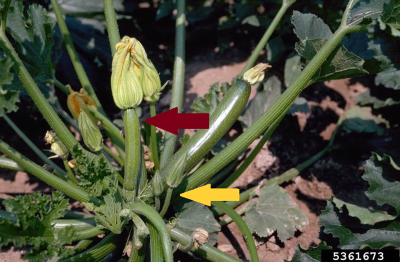Fruit Set on Vegetables

Last week’s high temperatures might be nothing but a memory now but the impact they had on our vegetable gardens will probably start to show up on our vegetable plants in several weeks. If we have nighttime temperatures above 75 and daytime temperatures above 85, tomatoes are unlikely to set any fruit even though they are blooming like crazy. The temperature causes the tomato plant to become stressed. This also changes the flowers and makes it harder for them to become pollinated. But don’t worry, once temperatures cool down a little bit the tomatoes will be back to producing enough fruit to feed a small village. If your plants weren’t blooming even before the heat but were developing in to big bushy plants you might have over fertilized them this spring. Overfertilization leads to vigorous plant growth but fewer blooms or fruit set. On tomatoes try not to fertilize with nitrogen till the plant has already set its first round of fruit to avoid excessive vegetative growth. Green beans will also drop flowers if there are hot temperatures over 95 degrees especially if the soil is dry.
Vining crops such as squash, cucumbers, watermelon and pumpkins can have a different issue. They have male and female flowers on the same plant. Typically, the early blooms are all male flowers which means there won’t be any fruit from them however after a few weeks the plant finds a balance of male to female flowers. It’s easy to distinguish the male from the female flowers as the female flowers have a tiny fruit behind the blossom (in photo burgundy arrow (top) is the female flower, yellow arrow (bottom) is the male). The heat can also change which types of flowers that are created with higher temperatures (90 degrees during the day and 70 degrees or warmer at night) favoring having more male flowers instead of female flowers.

If you have both male and female flowers but still aren’t getting fruit set make sure you are seeing pollinators visiting the flowers. Tomatoes are pollinated by wind typically and don’t necessarily need pollinators but vining crops do. If you don’t see many pollinators visiting your garden try using a paint brush to transfer pollen from male to female flowers. If you are only getting fruit on the flowers you pollinated you need more pollinators. Much like the flowers, bees don’t like it really hot and will start to decrease their pollination when temperatures get above 90 degrees. Once temperatures start to cool down the bees and the flowers will go back to normal. Till then we just have to water as needed and wait for the temperatures drop again.

Have questions? Contact our office where our Horticulture Extension Agent will assist you with questions.
Phone: (316) 321-9660
Email: callae@ksu.edu